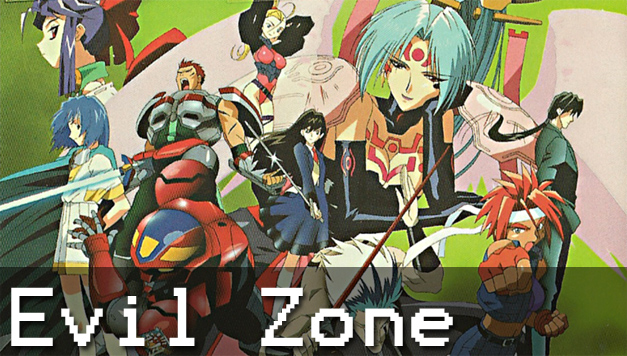
 | Evil Zone Developer: Yuke's Future Media Creators |
I believe the first time I saw Evil Zone was during a commercial. It seemed pretty scary because the commercial portrayed it in a dark light. I wanna say they were touting things like how it was a fully 3-D fighting game that also allows you to use weapons and special techniques that can send your opponent flying across the stage. While the aspects are true, the dark nature of the game is not bad at all. In fact, it basically setup like an anime series.

Evil Zone, or its real name, Eretzvaju, is a polygonal 3-D fighting game that was developed by Yuke's Future Media Creators; a developer who will soon find themselves creating a niche for themselves in the fighting genre in the years to follow this game. The basic story is that there is a being called Ihadurca, who was captured and trapped in a dimension known as Evil Zone. Now the inhabitants of I-Praseru (Happy Island), who originally captured Ihadurca, have to gather the greatest warriors to face Ihadurca again to make sure she doesn’t escape from Evil Zone.
Probably the most interesting aspect regarding this game is the gameplay, which has only one button for attacking! The entire control scheme uses two buttons and the d-pad. One button, as described earlier, is for attacking (triangle), and the other is for blocking (square). This is bonkers compared to other fighting games from companies like SNK and Capcom, which try to use every button on the controller, including the shoulder buttons.

Each character can perform a number of attacks based on pressing either up, left, or down on the d-pad while pressing the attack button. Basically all of the characters use the same combo lists, but each attack is unique to each player, so once you’ve figured out the moves for one character, you’ve figured it out for the whole roster.
When it comes to the stories, this game takes the cake when it comes to trying something different. Each character’s story is presented as a television series. Every match is one episode and every episode has an episode title card, an opening in-game cut scene, the battle itself, commercial bumpers, closing in-game cut scene, and then a preview for the next episode. Every character has a different show and a way of presenting it. For example, for Erel, we see her story unfold through her hand drawn drawings (very child like drawings) while Keiya answers letters in a comical fashion from upcoming opponents (comical is a stark contrast to his intensely serious personality).
Peppered throughout the game are anime cutscenes done by animation studio AIC, which have done shows such as Tenchi Muyo!, Burn-Up Excess, and Bubblegum Crisis. The intro is well done and the snippets they include during the credits are are a nice change of pace to the in-game cutscenes. As a matter of fact, I love how they kept switching all of the cutscenes with different types of styles. With in-game cutscenes, anime scenes, and still frames, it was always keeping things fresh for the eyes to admire.

Bonus credit goes to studio Yuke's for having the faces of the character models have expressions; especially with the eyes. When a character speaks, their mouths move too. However, this didn’t work too well with the english version which has terrible lip syncing. In fact, sometimes the lips would keep moving for up to five seconds after the english dialog stopped.
Eretzvaju is not a great fighting game, but it is one worth taking a look at if you are a fan of the genre because of its unique way of presenting each character’s story and its simplified control scheme.
Image credits: C&A Productions
Posted on: September 12, 2014
